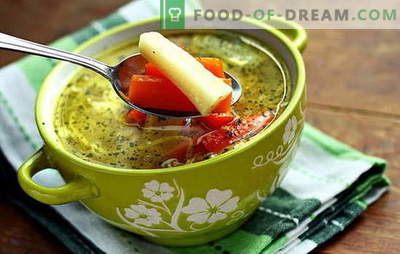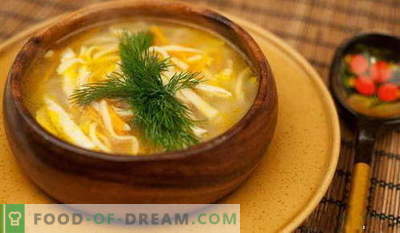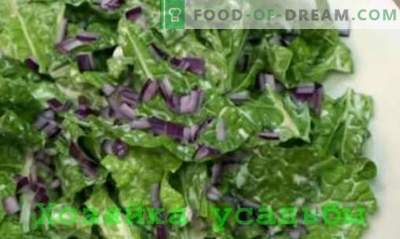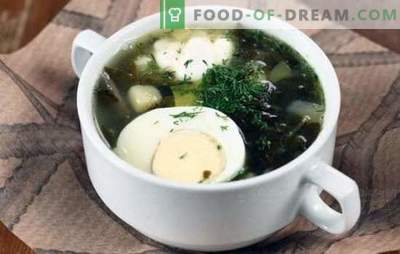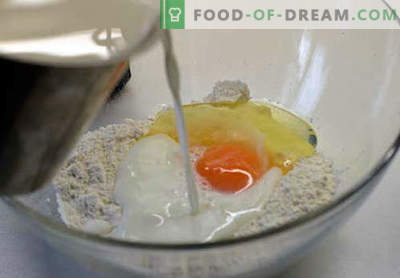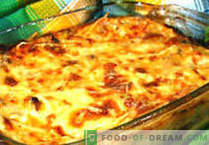
Korean soups are brewed not only from dogs, as many think!
In fact, there are a lot of very tasty dishes from the usual ingredients for us.
So why not cook them?
Korean Soup - General Cooking Principles
Korean soups are cooked with fish, vegetables, meat, algae, roots, tofu, mushrooms and other various products. And very often in one dish there are several different and, at first glance, incompatible ingredients. But it only seems so. In addition to the usual products, special mixtures or pastes are also added.
What unusual ingredients are found in Korean soups:
• Twendian (soybean paste);
• gochudyan (pepper paste);
• garlic paste (you can simply mash fresh cloves);
• kimchi (spicy, sauteed Peking cabbage);
• dashi (seasoning).
In many dishes there is already familiar to us soy sauce. Green onions, sour cream, and hot peppers are often used to fill Korean soups.
Recipe 1: Korean Cooky Soup with Beef and Noodles
The recipe for the traditional Korean soup, which is also called “kuksu”. It is prepared in different ways and this is only one of the options. Noodles can be used any, but better egg.
Ingredients
• 300 grams of beef pulp;
• 80 ml of vegetable oil;
• 200 grams of white cabbage;
• 2 cloves of garlic;
• 100 grams of noodles;
• 300 grams of fresh cucumbers;
• cilantro greens;
• 2 eggs;
• 100 grams of radish;
• cayenne and black pepper;
• 1 liter of water;
• sugar, salt, vinegar, soy sauce.
Cooking
1. Cut the beef pulp into thin strips, fry in vegetable oil for two minutes.
2. Add the shredded cabbage and fry together.
3. Put both types of pepper, pour in a little soy sauce, reduce the heat and simmer for about ten minutes. If the cabbage is juicy and soft, then it is possible less.
4. Cut radishes and cucumbers into strips, add chopped cilantro, garlic, some vinegar and oil, and mix.
5. Separately boil noodles, lubricate with oil.
6. Eggs, beat with a fork and bake two thin pancakes, cool, roll and slice noodles.
7. How kuksi is served. Put meat and cabbage in a plate, add noodles, next to them lay a salad of cucumber with radish, and omelette noodles on top. All pour salted broth and you're done!
Recipe 2: Korean Miekkuk Soup with Seaweed
Recipe national Korean soup, which is usually cooked for birthdays. You will need canned sea kale, preferably without extra additives. Green peas are also used canned.
Ingredients
• 250 grams of seaweed;
• 3 potatoes;
• 120 grams of green peas;
• 1 egg;
• 1 carrot;
• 1 small onion;
• 2 liters of broth;
• sour cream;
• spices;
• butter.
Cooking
1. Onion finely chopped, fry in a skillet. After a minute, add the grated carrot.
2. Put the broth on the stove, add salt and after boiling add diced potatoes. Cook for ten minutes.
3. While the potatoes are boiling, boil a hard-boiled egg, peel, cut into small cubes.
4. Add previously fried vegetables.
5. Next lay the sea cabbage. With it you need to drain the broth. If there are spices, then remove. Often put onions, it also needs to be removed.
6. After boiling cabbage throw peas.
7. Add an egg, put spices to taste and turn them off.
8. When serving in each plate put a spoonful of sour cream and herbs.
Recipe 3: Korean tofu soup
Unusual, but fairly well-known first course. For this Korean soup you will need soft tofu, its amount is not strictly defined. Add “by eye”.
Ingredients
• 2 liters of rice water;
• 1 zucchini;
• tofu;
• 1 leek;
• 2 tablespoons of twendian (soybean paste);
• 1 spoon of crushed garlic;
• 0.5 tablespoons of dashi seasoning;
• 200 grams of oyster mushrooms;
• 3 potatoes.
Cooking
1. Cooking rice water. To do this, take a couple of glasses of rice, rinse, drain the water. Fill with two liters of new liquid and wash intensively. You can let stand for a few minutes. We use rice for any dishes, and pour the water into a saucepan and put the soup to cook.
2. Add soybean paste, seasoning dashi, twendyan, crushed garlic, give boil.
3. Put diced potatoes, cook for five minutes.
4. Add the chopped zucchini, mushrooms and cook for about five minutes.
5. Put the tofu, cut into cubes and bring the soup to full readiness. Focus on the readiness of vegetables.
6. At the end add leek and turn off, if necessary, then salt. Often gochudyan pasta, which is made from red pepper, is added to this dish.
Recipe 4: Korean Kimchi Soup
Until now, Koreans and Japanese can not share this dish. And everyone considers it their own national. The technology of preparation in both countries is similar and has many subtleties. But now there are simplified options, for example, this one. Kimchi - spicy sauerkraut, mainly used Peking.
Ingredients
• 400 grams of pork loin;
• 1 onion;
• 10 grams of chili sauce;
• 2 spoons of vegetable oil;
• 250 grams of kimchi;
• 2 spoons of soy sauce;
• green onions;
• salt, black pepper;
• 3 cloves of garlic.
Cooking
1. Cut the loin into small pieces. Add water and when boiling remove the foam.
2. We throw the peeled, but whole bulb. After half an hour, it will need to be removed, and the broth is boiled for another thirty minutes until the brisket is ready.
3. Kimchi fry in a pan for a few minutes. As soon as it becomes softer and more transparent, you can turn it off.
4. Combine hot chili sauce, garlic, a pinch of black pepper. Instead of chili sauce, you can simply take the red pepper puree twisted in a combine. Add soy sauce and mix everything well.
5. Put the fragrant mixture in the pan.
6. Add roasted kimchi cabbage.
7. Cook everything on low heat for about five minutes, salt to taste.
8. When serving, sprinkle with green onions, you can add tofu pieces.
Recipe 5: Korean Radish Soup
White Korean radish daikon is commonly used for this Korean soup. But you can also take radishes. You will also need dried sea kale.
Ingredients
• 800 grams of radish;
• 2 spoons of vegetable oil;
• 1 bunch of green onions;
• 20 grams of dry sea kale;
• 3 cloves of garlic;
• 60 ml of soy sauce.
Cooking
1. Clean the radish. If the roots are young and the skin is intact, then you can just wash well. Cut the radish into cubes, pour water and put on the stove. Cook for three minutes.
2. Fry the green onions in the butter, just a little.
3. Add soy sauce, garlic and sea kale to the pan.
4. Cook the soup until the radish is soft, at the end add the roasted green onions, turn them off.
Recipe 6: Korean Seafood Soup
Recipe for light Korean soup, which will need shrimp and fish with white meat. You can use cod. Ingredients
• 0.6 kg fish fillet;
• 0.5 kg shrimp;
• 1 spoon of gochujana pasta;
• 20 ml of sake;
• 1 spoon of sesame oil;
• 2 cloves of garlic;
• 300 grams of daikon;
• 1/3 cup anchovy;
• 2 spoons of soy sauce;
• 1 liter of water;
• 150 grams of tofu;
• 1 bunch of green onions.
Cooking
1. Cut the washed fish fillets into strips of 2 centimeters, put them in a saucepan with sesame oil, add spicy Korean pasta, garlic and soy sauce. Mix and let stand for half an hour.
2. Then just turn on the stove and grill it on low heat for about ten minutes. Often do not need to mix, so as not to damage the pieces of fillet.
3. While the fish is cooking, boil water and boil the anchovies in it, three minutes is enough.
4. Spread daikon cubes to anchovies and cook until soft.
5. Add peeled shrimps to the soup and after a minute, spread fragrant fish and diced tofu from a saucepan.
6. Cook all together for four minutes, do not let us actively boil, add sake at the end.
7. Turn off and lay out in plates, serve hot soup with green onions.
Korean Soup - Tips and Tricks
• Green onions in Korean soups are much more common to any other greens. To feathers quickly and neatly cut, you can use regular scissors. And you can even cut a bow over a plate.
• Korean cuisine is rich in spices and hot spices. But all this is not necessary to add. If some ingredient does not suit or is simply missing, then it can always be excluded.
• No dried sea kale? You can take a sheet of noria and just cut noodles. Of course, not quite a cabbage will turn out, but not bad either.






